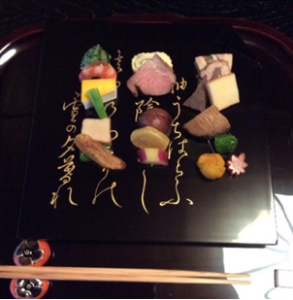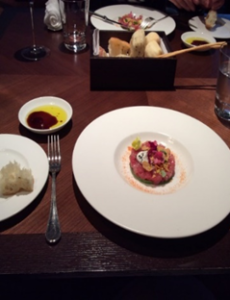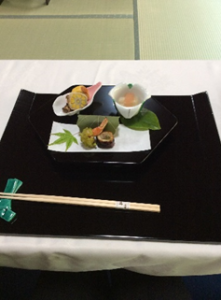Chopsticks, Fork and Toothpick
Yoshie Doi
 |
 |
 |
Prince Shotoku was the first person in Japan to use chopsticks, and it is said that the system of eating with chopsticks was adopted in banquet ceremonies at the imperial court. When Imoko Ono was dispatched to China, she was welcomed with chopsticks, and in 608 (Emperor Suiko era), she held a banquet at the imperial court with 12 people, including the Zui envoys, who returned to Japan with her, using the latest chopstick eating etiquette. We will hold an event. Two stick-shaped chopsticks were used. This was the first historical step in Japan to use chopsticks to eat. (Chopstick eating system announced) At this time, the chopsticks used were cypress, cedar, and mizuki (Japanese cypress) wood.
With the visit of Chinese envoys to the Zui Dynasty, chopstick etiquette was adopted in Japan. Until then, people had eaten with their hands, but the Chinese style of eating with chopsticks was adopted. At the beginning of the 8th century, with the construction of Heijo-kyo, the system of eating with chopsticks was introduced in earnest, and a revolution in life was brought about from eating with one’s hands to eating with chopsticks. Representative temples also actively adopted chopsticks, and eating with chopsticks gradually became popular.
However, at the end of the Yayoi period, “Oribashi”, which were sacred treasures made from thinly shaved bamboo and bent like tweezers, were used only when making offerings to the gods, and they were not widely used, and only the emperor at that time had tweezers. It is said that they used chopsticks like this. It still exists in Shosoin. It is surprising that the original type of chopsticks we use today was used in that era. In China, chopsticks of the same thickness are still used today. In China, chopsticks of the same thickness are still used today. Chinese people who come to Japan seem to be impressed by the ease of using Japanese chopsticks.
Currently, 30% of humans use chopsticks, 30% of humans use forks, and 40% of humans eat with their hands.
Cultural and historical differences in how to place chopsticks and knives and forks
In Japan, since ancient times, during the autumn harvest, people have thanked the gods for the safe harvest and made offerings to the gods before eating. The biggest event of the festival was the communal eating of the gods and humans, in which the gods and humans shared the offerings made during the festival. One of the ends of the chopsticks is used by God, and the other end is used by humans, and double-ended chopsticks are used as proof that God and humans are one.
In this way, the ancient Japanese custom of offering to the gods and then receiving them is the reason why chopsticks are placed at the barrier between gods and humans. Therefore, place your chopsticks parallel to the person who is eating. Chopsticks are used as a substitute for the right hand, and while Japanese food is cut into small pieces and served, Western food is eaten using both hands, stabbing chunks of meat with a fork and cutting into pieces with a knife. Hold the chopsticks in place and bring the food to your mouth. The Japanese style is to hold chopsticks in your right hand and a bowl in your left hand, while in the West you hold a knife and fork with both hands, so you leave the bowl on the table when you eat. This is the biggest difference.
Western knives and forks are placed perpendicular to the person eating, as the knife and fork are taken from both ends according to the meal.
Japanese people and the hunting people of the West can be seen in the way they eat.
New Year’s Day is the most auspicious day of the year, and the chopsticks used on this day are Shiraki-bashi, double-ended chopsticks. This has the meaning of “God and man cannibalism”, where one side is used by God and the other is used by humans. Medium thick and thin. They are called “fat chopsticks,” “Tawara chopsticks,” and “Harami chopsticks,” and are used as symbols of a rich harvest and the prosperity of descendants. These double-mouthed chopsticks are used as chopsticks for special occasions, as well as formal chopsticks for ceremonial occasions and main meals.
If you put these chopsticks in Mizuhiki chopstick paper (chopstick bag) and write each person’s name on them, it will make the chopsticks even more auspicious.。
In the past, Zoni, which is essential for celebrations, was called “Hozou,” meaning to strengthen the five internal organs and maintain health. Although rice cakes are the main ingredient, they are served with various toppings, and this custom still exists in China and Korea.
When we go to a restaurant or restaurant, toothpicks are always provided at the end of the meal. This is surprising, but Neanderthals 100,000 years ago also used toothpicks. Traces of toothpick use have been found in fossilized teeth. Toothpicks were introduced to Japan in the Nara period as Buddhist tools along with Buddhism.
It is said that the origin of the toothpick and toothbrush is that the Buddha (500 BC) taught his disciples to brush their teeth using neem tree branches. Does this mean that purifying one’s body starts with cleaning one’s teeth and mouth, which are the entrance to eating? Therefore, toothpicks were a Buddhist tool when they were introduced to Japan.
In China, they didn’t have this tree called neem, so they used willow. Willow branches came to be called toothpicks.
By carrying toothpicks with them at all times, the toothpicks were passed down to the aristocrats who had close friendships with the monks, and it became a custom to brush your teeth with toothpicks in the morning. This was used by Kabuki actors and courtesans during the Edo period, and quickly spread to the common people. This was handed down as a toothpick that was used as a toothbrush.
The end of document
Translated by Masami Otani
